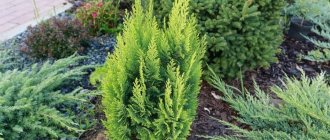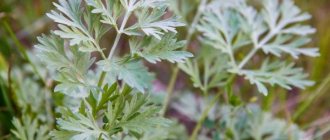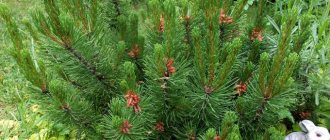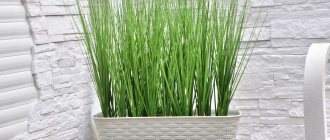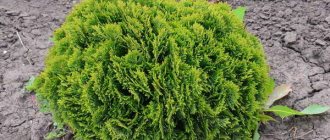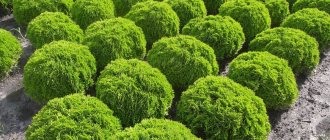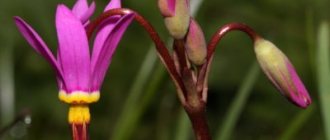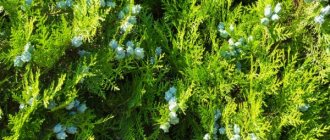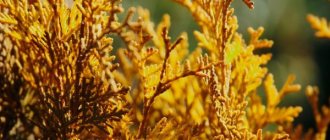Red Baron bladderwort is rightfully considered one of the most original shrubs. Gardeners liked it not only for its unusual and chic appearance, but also for its ease of care. Red Baron grows quickly, while maintaining its decorative value throughout the growing season, and is therefore widely used for landscaping city parks and private households.
Description of the Red Baron bladderwort
Red Baron bladderwort was brought from North America, where it most often grows on river banks. The bush is tall and belongs to the viburnum-leaved species. Its five-lobed leaves are very reminiscent of viburnum leaves. The flowering period begins in June-July. The fruits ripen in early September.
Description of Red Baron viburnum
| Height | about 2 m |
| Bush shape | round, spreading |
| Branches | arcuate |
| Flowers | white-pink with a red stamen, collected in inflorescences, hemispherical, corymbose in shape |
| Fruit | prefabricated, red blown leaflets |
| Leaves | 5-7 lobed, 7-10 cm in diameter, rounded-elliptical in shape, dark red in color, which becomes bronze in autumn, in the shade the foliage is green, with a reddish tint |
Kinds
There are more than 10 species of this plant, but only two species are widespread in cultivation in the European part of the country:
- Amur bladderwort (Physocarpus amurensis)
- Physocarpus opulifolius
Unpretentious, decorative and fast-growing vesicles are an excellent material for hedges. They tolerate pruning well, with which the bushes can be easily given the desired shape.
The Amur bladderwort is used less frequently in landscaping, but the most widely used plant is the viburnum-leaved bladdercarp in landscape design.
1
Amursky
Amur bladderwort
The homeland of this shrub is the mixed forests of the Far East, North Korea and northern China. The bushes grow up to 3 meters in height.
The crown has a wide spherical shape, green leaves and blooms with small white flowers collected in corymbose inflorescences.
The fruits are swollen leaflets that turn red as they ripen and give the plant an attractive appearance and decorative appearance in the fall. This species is winter-hardy.
The shoots become completely woody. The plant is used both in single and group plantings, as well as as hedges.
2
Bladderwort viburnum
Bladderwort viburnum
This plant is native to North America, where it grows wild. The shrub got its name because of its leaves, which are similar to those of viburnum.
For decorative decoration of a garden plot, mainly two groups of varieties of viburnum are used: plants with red leaves and with yellow foliage.
In each of the groups, breeders have developed many varieties, which are worth dwelling on in more detail.
Red Baron bladderwort in landscape design
Red Baron is popular among landscape designers due to its unusual appearance. All its parts are decorative, including foliage, flowers, and fruits. You can meet the bladderwort on city streets and in rural courtyards. Park areas, front entrances, and summer cottages are decorated with this bright shrub.
Red Baron often becomes an element of complex garden compositions, in which it can occupy both a dominant position and act as a background for other plants. The bladderwort bush can be an excellent tapeworm in the undergrowth, against the background of deciduous and coniferous compositions.
Red Baron looks great in single and group lawn plantings. An original design solution is to trim the bushes. At the same time, the bladderwort gets a unique shape, which in combination with other garden crops gives an amazing effect.
Hedges made from Red Baron bladderwort (pictured) can adequately decorate any recreation area or garden of a country house. They turn out dense, thick and incredibly beautiful, without requiring special care.
Description
Speaking about descriptive characteristics, first of all I would like to note that it belongs to the Rosaceae family and to typical deciduous plants. Depending on its species, the bladderwort can change the color of its leaves from bright green to bright red in the autumn. And at the height of flowering, which occurs at the beginning of summer, in June, miniature flowers appear on the bush, resembling the shape of a bubble in appearance, which is why the name of this representative of the flora, which has a Latin interpretation - Physo (bubble).
Variety Diabola
The height of the bush can reach about three meters. The leaves have a semi-oval shape, their size can vary from two to seven centimeters. Externally, the leafy platinum is very similar to the foliage of the common viburnum; it also has an average of three lobes and a jagged edge. What is interesting is that the leaves do not lose their original color until the very beginning of the winter period. The bark of the bush is bright brown in color and looks quite interesting. During the flowering period, which usually begins in mid-June, the shrub is covered with fragrant inflorescences that have a pinkish-white tint. Miniature flowers are collected in brushes that look like neat umbrellas, the size of which is approximately about five centimeters. The flowers themselves have five sepals and petals and many small stamens, bright red. Their bizarre arrangement makes the flowers fluffy and very beautiful.
Bladderwort bush
The bladderwort is distinguished by a relatively active growth process. The plant is not capricious with regard to growing conditions, and therefore can exist in both drought and frost conditions, and grow in semi-shady areas . In the early stages of its development, the bush forms many root shoots, this is one of the reasons why the bush can easily develop in dry soil. In this regard, many florists recommend planting lilac, pomegranate, and wolfberry next to the bladderwort, which will contribute to a bright color and pleasant aroma during flowering.
We also recommend reading
- Landscape design of a small summer cottage
- Rose park
Planting and caring for Red Baron bladderwort
Red Baron bladderwort, according to the description of the variety, does not require any specialized care, but will only fully develop when the following agrotechnical measures are carried out.
| Watering | 2-3 times a week, especially during hot periods |
| Top dressing | in the spring-autumn season |
| Loosening the root circle | regularly, being careful not to damage the root system |
| Soil treatment against pests | in the spring for preventive purposes |
| Trimming | 2 times per year |
Important! It is recommended to plant planting material with an open root system in early spring (before buds open) or autumn (in September). Plants in pots or containers can be planted throughout the growing season.
Preparing the landing site
It is recommended to choose a site for planting Red Baron bladderwort with loose soil rich in nutrients. But due to its undemanding nature, bladderwort will also grow on insufficiently fertile substrates. The composition of the soil can be completely different, the main thing is that there is no lime in it. Also, the bladderwort develops quite poorly on soils with high groundwater levels.
Comment! Red Baron is absolutely insensitive to air polluted by exhaust gases. Thanks to this, it can be planted near the roadway.
Landing rules
Planting Red Baron bladderwort begins with preparing a planting hole for the seedling. Step-by-step process of preparatory and planting work:
- Dig a hole of sufficient depth (the root collar should be flush with the ground).
- Place a layer of nutritious, fertile soil at the bottom.
- Place the seedling vertically in the hole.
- Sprinkle the root with soil, lightly tamping it down.
- Water the seedling.
- After three to four days, loosen the soil.
- Mulch the root zone with peat, humus or dry soil to retain moisture.
Advice! The optimal soil for planting Red Baron viburnum, as for any other ornamental plants, should be multi-component.
When planting, the branches of the seedling should not be buried more than 1-2 cm into the ground. Some time after shrinkage, soil must be added to level the surface. Hilling up is not recommended.
When planting Red Baron bladderwort to create a hedge, the seedlings should be placed in a checkerboard pattern (in a two-row manner).
Recommended distance:
- in rows – 35 cm;
- between seedlings – 45 cm.
Watering and fertilizing
The frequency of watering Red Baron bladderwrack bushes depends on a number of factors, such as:
- type of soil;
- plant age;
- climatic region in which the shrub grows.
Advice! When growing bladderwort on light loams in areas with hot summers, it is recommended to water the plantings from late spring until the onset of the autumn season. Do not over-water on lawns or heavy clay soils. Overwatering increases the risk of powdery mildew, which can be destructive to plants.
Ornamental bushes of the Red Baron variety should be watered regularly, 2-3 times a week. The water consumption rate per plant is about 40 liters.
It is necessary to feed the viburnum leaf carp:
- in early spring - nitrogen fertilizers;
- in autumn - mineral.
| Top dressing (per 10 liters of water) | |
| in the spring | in autumn |
| · mullein – 500 ml; · carbamide (urea) – 25 g; · ammonium nitrate – 25 g. | · mullein – 500 ml; · carbamide (urea) – 25 ml; · ammonium nitrate – 25 ml; · phosphorus nitrate – 50 ml. |
Advice! The consumption rate of feeding solution for 1 adult bush (15-20 years old) is 15 liters.
Trimming
Red Baron viburnum is a fast-growing variety. Growing in comfortable conditions, the bush can produce about 40 cm of growth in both width and height in a year. Therefore, the plant needs not only sanitary pruning, but also formative pruning. The procedure is not traumatic for the plant. The bushes easily tolerate it and very quickly sprout new shoots.
Sanitary pruning is carried out in the spring. Its main purpose is to remove broken and frozen branches. Bush-forming pruning helps give the bush the necessary shape and stimulates branching. It is carried out in the spring (before buds open) or in the fall (after the end of the growing season).
Red Baron, like other varieties of bladderworts, grows like a fountain, and correctly carried out formative pruning helps to activate the growth processes of the upper buds. Crown-forming pruning can be done in two ways:
- The trunks of the bush are cut at a height of 40-50 cm to obtain a powerful, wide bush.
- At the base of the bush, all thin and weak shoots are removed. Leave about five of the strongest trunks, cutting them at a height of 1.5 m, thereby stimulating their growth. At the same time, the bush acquires a pronounced fountain-like shape.
Preparing for winter
The Red Baron bladderwort is resistant to slight drops in atmospheric temperatures, but in severe winters, young shoots can sometimes freeze. In order to prevent possible freezing, the bushes should be properly prepared for wintering in the fall. It is recommended to begin preparatory work with the arrival of the first cold nights.
Step-by-step plan for insulating the viburnum vesicle:
- The bushes are tied together with rope or twine.
- Wood shavings or peat are laid out around the trunk of the plant.
- The shrub is covered on top with any natural insulating material.
Advice! It is imperative to cover seedlings and young bushes of the Red Baron bladderwort for the winter.
Trimming
Red Baron viburnum is a fast-growing variety. Growing in comfortable conditions, the bush can produce about 40 cm of growth in both width and height in a year. Therefore, the plant needs not only sanitary pruning, but also formative pruning. The procedure is not traumatic for the plant. The bushes easily tolerate it and very quickly sprout new shoots.
Sanitary pruning is carried out in the spring. Its main purpose is to remove broken and frozen branches. Bush-forming pruning helps give the bush the necessary shape and stimulates branching. It is carried out in the spring (before buds open) or in the fall (after the end of the growing season).
Red Baron, like other varieties of bladderworts, grows like a fountain, and correctly carried out formative pruning helps to activate the growth processes of the upper buds. Crown-forming pruning can be done in two ways:
- The trunks of the bush are cut at a height of 40-50 cm to obtain a powerful, wide bush.
- At the base of the bush, all thin and weak shoots are removed. Leave about five of the strongest trunks, cutting them at a height of 1.5 m, thereby stimulating their growth. At the same time, the bush acquires a pronounced fountain-like shape.
Reproduction of Red Baron.
Red Baron viburnum leaf carp reproduces:
- layering;
- cuttings;
- dividing the bush.
Warning! It is not recommended to grow Red Baron viburnum leaf carp using seeds collected with your own hands, as you can get plants that do not have characteristic decorative features. During seed propagation, the original color is not always transmitted.
Propagation of the vesicular carp by layering gives good results. For layering on adult bushes, strong, healthy shoots that grow outward are selected. Before planting, all foliage is removed from them, with the exception of the top. Then they make a groove 15 cm deep, into which the prepared shoot is placed. Be sure to secure the layer by pinning it to the ground, for example, with wooden or metal brackets. The top of the hole must be covered with earth. In the fall, the cuttings are separated from the bush and planted in a permanent place.
Cuttings for propagation are prepared as follows:
- Before flowering begins, young branches at least 20 cm long are cut from the bushes.
- The leaves are removed from the lower part of the shoot, and the remaining ones are shortened by half.
- The branches are placed in the Kornevin solution for 2-3 days.
- When the first signs of the formation of a future root system appear, the cuttings are planted in nutrient soil.
- The seedlings are covered with film for the summer, periodically ventilated and watered. They are insulated for the winter.
Attention! Shoots that are selected for propagation must have 2-3 bud internodes. The soil for planting them should be similar in composition to the soil in which the shrubs will grow in the future.
Dividing the bush is the fastest way to propagate. But due to the fact that adult bushes have a highly developed root system, this option is quite labor-intensive.
Buy Red Baron Physocarpus opulifolius Red Baron – in Florini nursery
Buy Red Baron with beautiful pale pink flowers (Physocarpus opulifolius Red Baron), in Voronezh with delivery throughout Russia wholesale and retail at the Florini nursery.
Description of the “Red Baron” bladderwort Physocarpus opulifolius “Red Baron”
Using the viburnum vesicle “Red Baron” you can create multi-level hedges. The crown diameter of an adult plant is 2 m. The height of an adult plant is 2 m.
Dense bush with numerous straight shoots forming a dense, hemispherical crown Leaves 3-5 lobed (up to 7 cm), corrugated along the veins, elongated, narrower than Diablo, dark red, in full shade - green with a slight reddish tint, in autumn - bronze Flowers numerous, pale pink, collected in corymbs up to 5 cm, flowering from early to mid June. Fruits - prefabricated swollen red leaflets
Prefers sunny places, tolerates partial shade and shade, losing only the intensity of coloring. It is not picky about soil, but prefers loamy, acidic soil. Does not tolerate stagnant moisture. Tolerates urban pollution well. Frost-resistant, but young shoots may freeze.
How to plant bladderwrack with a closed root system.
The plant tolerates shade, but the color of the leaves fades over time when shaded, so it is advisable to plant this shrub in an open and sunny place. There are only two conditions for the soil of the shrub - the absence of lime and the presence of drainage.
Of course, the bladderwort will look more luxuriant on fertile, loose and fresh soil, but it will also look good on a substrate poor in nutrients.
Another advantage of this plant is its resistance to air pollution, so it can be safely planted next to roads.
1. For seedlings with a closed root system, purchased in containers or simply with a ball of earth, there are no strict time limits for planting. They can be planted in any season, regardless of weather conditions, the main thing is the ability to dig holes.2. It is advisable to plant seedlings with bare roots immediately after purchase.
You should buy bare-root plants before buds open or after leaf fall. If you need to postpone this event for a while, you can temporarily bury them in some shaded place, or wrap the root system in damp textiles, or place the roots in a plastic bag.
The hole for planting should be twice as large as the root ball. Loosen the soil properly to promote root growth. Carefully remove the seedling from the container. The plant may remain in the container for too long, causing its roots to become entangled.
This is not a bad thing, but the roots need to be untwisted before planting and several vertical cuts need to be made across the ball to encourage new root growth to be properly oriented. Then we put the plant in the hole and fill it with either dug up soil or using additives.
Deciduous shrubs are best planted deeper. In this case, they form additional roots on the branches, which stimulates the germination of a large number of fresh shoots.
After planting, pat down the soil around the plant so the roots have direct contact with the soil. Then you need to water the plant well.
Reproduction
Bladderwort is easy to propagate on your own - by layering or cuttings, like currants, or by dividing a bush. The seed method is also possible, but the fact is that seedlings rarely inherit the characteristics of the mother plant from which the seeds were taken. Besides, this is a troublesome task. The vegetative method of plant propagation is more reliable and gives consistently quick results.
Growing and care
Prefers sunny places, tolerates partial shade and shade, losing only the intensity of coloring. It is not picky about soil, but prefers loamy, acidic soil. Does not tolerate stagnant moisture. Tolerates urban pollution well.
Frost-resistant, but young shoots may freeze. Bladderwort grows on all types of soils that are moderately moist and have good drainage. Grows in both sun and partial shade.
Care consists of periodic watering, fertilizing, loosening the soil and pruning old shoots.
Diseases and pests
Another advantage of the bladderwort is that it is practically not affected by diseases and pests. It is rare to observe leaf chlorosis - when the tips of the shoots dry out and the foliage turns yellow, the veins remain green.
This is due to a lack of microelements in the soil: elements of iron, magnesium or nitrogen, or waterlogging of the root ball. Chlorosis can be caused by viruses and microorganisms that are carried by pests.
Applying complex fertilizers with watering or spraying the foliage with chelated compounds will help the bladderwort restore health.
Application in landscape design
Source: https://www.florini.ru/products/puzyreplodnik-red-baronphysocarpus-opulifolius-red-baron/
Diseases and pests
Red Baron bladderwort is highly resistant to many diseases and pests. But for preventive purposes, it is recommended to carry out spring tillage of the soil with antifungal and bacterial drugs. This procedure will contribute to better development of the bush and its growth.
For hygienic purposes, it is recommended to add drugs such as Fitosporin, Alirin, and Gamair to the water for irrigation. The dosage is prescribed in the instructions for each specific product. Watering is carried out in the spring, and one such preventive procedure is enough to protect plants for the entire growing season.
Sometimes Red Baron bladderwrack bushes can become affected by blight. The disease develops when plants grow in poor soils. In particular, it is provoked by a lack of iron in the soil. A characteristic sign of the disease is the rusty color of young leaves and shoots, followed by their drying out. The cause of the disease can be eliminated by watering the bushes at the roots with iron-containing preparations (“Firolitam”, “Iron Filate”).
Features of cultivation and care rules
The features of planting Red Baron viburnum are practically no different from planting other varieties of bladderwort. Choose a sunny place for this plant so that the foliage shows all its decorative qualities. Red Baron viburnum grows well in the shade, but the leaves turn green. The bush will look very ordinary.
Young seedlings with an open root system are selected in early spring or autumn, before the onset of the first frost. The appearance of the seedling will tell you about its health. Before planting, the roots must be soaked in water for two to three hours so that they are not too dry. Plants from containers can be planted all season long.
Planting holes are dug to a depth of 60 centimeters, into which nutrient soil is poured. Red Baron does not have any special requirements for soil conditions, but does need a good drainage layer. After planting, the soil around the seedlings should be compacted well and watered abundantly.
The fast-growing shrub usually tolerates severe frosts well. But young shoots and the tops of old branches can freeze. Therefore, in early spring it is necessary to do sanitary pruning. The Red Baron variety of bladderwort is also pruned to give it some kind of garden shape. This has a good effect on the growth and further development of the bush.
The plant tolerates drought well, but can die from stagnation of moisture. The rules for caring for it are quite simple: timely pruning, fertilizing, fairly infrequent watering, loosening the soil and removing weeds. This type of bladderwort is very resistant to diseases and pests. However, preventive treatment will avoid possible problems.
A fast-growing plant will fill unprofitable voids in your garden within 1 – 2 years. The height of the bush can reach 2–3 meters. The crown diameter is the same.
This variety of bladderwort is propagated by dividing the bush, layering or cuttings. Growing by seeds is not recommended, since young seedlings will not take on all the decorative qualities of the mother plant.
8 Reproduction
Shrubs can be propagated in several ways:
- sowing freshly harvested seeds before winter;
- dividing the bush;
- stem layering;
- cuttings.
When grown from seeds, they are pre-stratified at cold temperatures for a month. With this method of propagation, grown seedlings most often will not inherit varietal qualities. Varieties with a golden color pass on the original leaf color to only part of their offspring. Most red-leaved varieties produce the original green color. Growing from seeds takes a long time. Therefore, the plant is best propagated vegetatively - by dividing the bush, layering and cuttings.
You can purchase ready-made seedlings in specialized stores. Seedlings purchased in pots can be transplanted into open ground at any time of the year - autumn, spring or summer. Seedlings without a clod of soil are planted in spring or autumn.
An open area of land is chosen for planting. Bladderworts with green foliage can grow in partial shade. To allow the soil time to settle, it is better to dig a hole 1-2 weeks before planting. The root collar of the seedling is not buried in the ground. A seedling purchased in a store is watered with water and removed from the pot and planted in a hole along with a lump of earth so as not to injure the roots. The hole is filled with fertile soil or a soil mixture of sand, peat and turf, after which the plant is watered abundantly. It is also recommended to pour a small layer of such soil before planting at the bottom of the dug hole. If the soil settles, the soil is added. The surface of the earth is mulched with peat or humus. Young seedlings need to be provided with constant soil moisture, but they should not be over-watered.
Propagation by cuttings is carried out in the following order:
- 1. Green shoots grown in the current season, 10-15 cm long, are selected from the plant. There should be 2-3 internodes on the cuttings.
- 2. The lower leaves are removed, the rest are cut in half.
- 3. The cuttings are soaked for a day in a solution of Kornevin or another root formation stimulator.
- 4. Prepare the beds for planting cuttings - add sand and peat to the soil.
- 5. After planting the cuttings, they are watered abundantly and covered with film.
- 6. Further care consists of watering and ventilation.
- 7. For the winter, the cuttings are protected from freezing with spruce branches or sawdust.
- 8. In the spring, young plants are transplanted to a permanent place.
To reproduce by layering proceed as follows:
- In spring, the strongest shoot of the plant is selected, which grows outward.
- All leaves are removed from this shoot except those that grow at the top.
- Next to the bush, prepare a groove 10-12 cm deep in the soil.
- Place the shoot in the groove, secure it with staples, and sprinkle it with earth.
- In summer, the buried shoot is watered, weeded and the ground is carefully loosened.
- In autumn, the branch is separated from the mother plant and covered for the winter.
Dividing the bush is done in spring or autumn, but since the plant is unpretentious, this can be done in summer. In this case, you need to try to divide the bush as quickly as possible so that the roots of the plant do not dry out.

